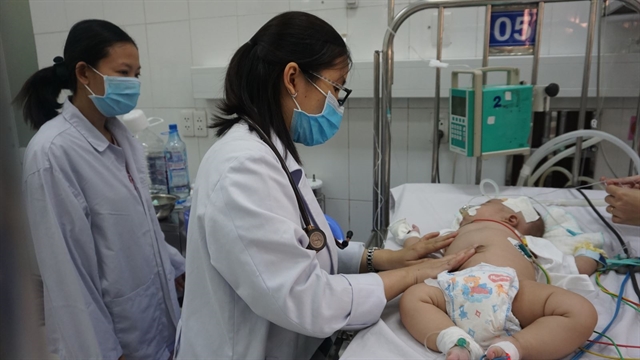 Society
Society


|
| A child diagnosed with a respiratory disease is treated at HCM City Children’s Hospital 2. VNA/VNS Photo Đan Phương |
HCM CITY — Children's hospitals in HCM City are seeing an increase in the number of children diagnosed with respiratory diseases.
Of those hospitalised, many are on a ventilator or using oxygen supplementation therapy.
The emergency rooms at the department for respiratory diseases at the City Children’s Hospital on September 16 had 10 newborns and infants aged 1 to 2 using oxygen supplementation therapy, a noninvasive form of respiratory assistance called nasal continuous positive airway pressure. Some were on a ventilator.
The children had been diagnosed with respiratory disease and were suffering from complications related to the respiratory tract caused by underlying health conditions.
Dr Trịnh Hồng Nhiên, head of the department for respiratory disease at the City Children’s Hospital, told Tuổi Trẻ (Youth) newspaper that several of them were premature babies and others had airway birth defects and immunodeficiency.
The department is treating 80 children, double the number compared to the previous two months, Nhiên said.
A 14-month-old boy from the Mekong Delta province of Trà Vinh was being treated with oxygen supplementation therapy because he had suffered a relapse of pneumonia. Previously, he had been on a ventilator twice when he showed signs of shortness of breath and other symptoms.
At Children’s Hospital 1, three emergency rooms at the department for respiratory diseases are filled with children on a ventilator or being treated with oxygen supplementation therapy.
A 7-month-old boy from Bà Rịa-Vũng Tàu Province had a fever and cough, and breathing difficulties, and was diagnosed with pneumonia by a doctor at a local health facility. He was given medicine, but his health became worse. He was then brought to Children’s Hospital 1 for further treatment, and after many days of treatment, his health has improved.
Dr Trần Anh Tuấn, head of department for respiratory diseases at Children’s Hospital 1, said the department was treating 157 children with respiratory diseases.
The current weather with high humidity and the back-to-school season are favourable conditions for increasing incidences of respiratory diseases among young children, according to doctors.
Respiratory disorders usually begin to increase in August and peak in September and October. They begin to fall in November.
According to Tuấn most children with respiratory diseases recover within 10-14 days. However, children who have a high fever for more than two days, and a sharp or stabbing chest pain that gets worse while breathing deeply or coughing, should be brought to health facilities for treatment.
Tuấn said these symptoms could be signs of more severe respiratory diseases and other dangerous conditions, including COVID-19.
Nhiên said that respiratory diseases can become severe rapidly and relapses can occur easily among premature babies, children with weakened immune systems, and malnourished children.
Caregivers and children should wash their hands regularly, wear a mask, avoid crowded areas, and avoid contact with people who have signs of disease, she added.
When a child is sick, they must be taken care of and watched closely. The child should only return to school after they recover, she said.
Children should get vaccinated and improve their resistance by eating nutritious food, taking vitamins, drinking a lot of water, and avoiding cigarette smoke.
Children under 6 months old should be exclusively breastfed to strengthen their immune system.
According to Tuấn, parents often mistakenly think that children who are coughing a lot are getting worse, and that less severe coughing indicates the child is only mildly ill.
However, the sign that accurately distinguishes between severe or mild illness is breathing. If the child breathes quickly and has sharp or stabbing chest pain that gets worse when breathing deeply or coughing, then the disease has become worse. VNS